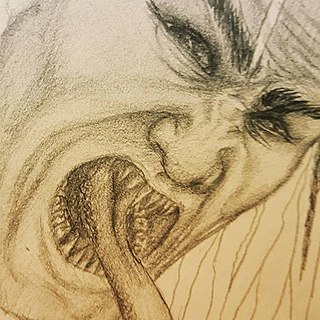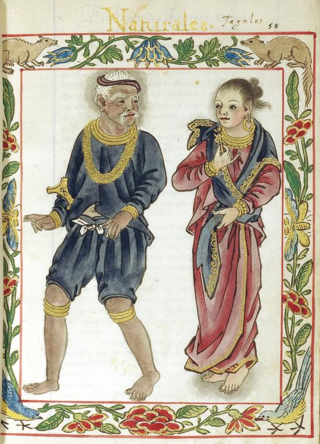
The manananggal is a mythical creature in the Philippines that is able to separate its upper torso from the lower part of its body. Their fangs and wings give them a vampire-like appearance.

Aswang is an umbrella term for various shape-shifting evil creatures in Filipino folklore, such as vampires, ghouls, witches, viscera suckers, and transforming human-beast hybrids. The aswang is the subject of a wide variety of myths, stories, arts, and films, as it is well known throughout the Philippines. Spanish colonists noted that the aswang was the most feared among the mythical creatures of the Philippines, even in the 16th century. Although with no specific motive other than harming others, their behavior can be interpreted as an inversion of the traditional Filipino's values. The aswang is especially popular in southern parts of Luzon, and some parts of Mindanao and Visayas, especially the Visayan province of Capiz.

The Tikbalang (/ˈtikbaˌlaŋ/) is a creature of Philippine folklore said to lurk in the mountains and rainforests of the Philippines. It is a tall, bony humanoid creature with the head and hooves of a horse and disproportionately long limbs, to the point that its knees reach above its head when it squats down. In some versions, it is a transformation of an aborted fetus sent to earth from limbo.

Biag ni Lam-ang is an epic story of the Ilocano people from the Ilocos region of the Philippines. It is notable for being the first Philippine folk epic to be recorded in written form, and was one of only two folk epics documented during the Philippines' Spanish Colonial period, along with the Bicolano epic of Handiong. It is also noted for being a folk epic from a "Christianized" lowland people group, with elements incorporated into the storytelling.

The Tagalog people are native to the Philippines, particularly the Metro Manila and Calabarzon regions and Marinduque province of southern Luzon, and comprise the majority in the provinces of Bulacan, Bataan, Nueva Ecija, Aurora, and Zambales in Central Luzon and the island of Mindoro.

William Henry Scott was a historian of the Cordillera Central and pre-Hispanic Philippines.

In early Philippine history, the Tagalog settlement at Tondo, sometimes referred to as the Kingdom of Tondo, was a major trade hub located on the northern part of the Pasig River delta, on Luzon island. Together with Maynila, the polity (bayan) that was also situated on the southern part of the Pasig River delta, had established a shared monopoly on the trade of Chinese goods throughout the rest of the Philippine archipelago, making it an established force in trade throughout Southeast Asia and East Asia.
The Sirena is a mythological sea creature from Filipino culture. In some regions of the Philippines, particularly Bicol and Visayas, Sirenas are known as Magindara and portrayed as vicious mermaids. Like Sirens of Greek mythology, they have alluring and irresistible singing voices; unlike Sirens, who are portrayed as part woman and part bird, Sirenas are often described as mermaid-like creatures living under the sea. In Philippine mythology, the Sirena is a mythological aquatic creature with the head and torso of a human female and the tail of a fish. The Sirena is an Engkanto –' the Filipino counterpart of English mermaids. Engkantos are classified as one of the Bantay Tubig, a Filipino term for mythical guardians of the water. In addition to the Sirena, other examples of Bantay Tubig are Siyokoy, Kataw, and Ugkoy. The male version of a Sirena is called a Sireno. Sometimes, Sirena are paired with Siyokoy. A popular mermaid character in the Philippines is Dyesebel.
The Kataw is one of the merfolk in the Philippine Mythology. In Visayan, Katau was believed to have higher rankings than other water and sea creatures as those of Sirena, Sireno and Siyokoy. It is believed that the Kataws are the reigning rulers of the kingdom Bantay Tubig.
Bungisngis is a one-eyed giant in Philippine folklore. This giant, purported to dwell in Meluz, Orion, Bataan and Batangas and is described as always laughing. The literal meaning of the name Bungingis is derived from the Tagalog word ngisi which means "to giggle".

The recorded history of the Philippines between 900 and 1565 begins with the creation of the Laguna Copperplate Inscription in 900 and ends with the beginning of Spanish colonization in 1565. The inscription records its date of creation in 822 Saka. The discovery of this document marks the end of the prehistory of the Philippines at 900 AD. During this historical time period, the Philippine archipelago was home to numerous kingdoms and sultanates and was a part of the Indosphere and Sinosphere.

Ma-i, or Maidh, was an ancient sovereign state located in what is now the Philippines.

The Philippines–Vietnam relations refers to the bilateral relations of the Republic of the Philippines and the Socialist Republic of Vietnam. Since the end of the Cold War, relations between the two countries have warmed significantly. Vietnam is sometimes referred to as the only communist military ally of the Philippines. Both nations have cooperated in the fields of education, tourism, agriculture, aquaculture, trade, and defense. Additionally, both nations have similar positions on the South China Sea issue, with Vietnam backing the Philippine victory in the ICC against China, and the Philippines backing to a certain extent the claim of Vietnam in the Paracels. Both nations have overlapping claims in the Spratlys, but have never made military confrontations as both view each other as diplomatic allies and ASEAN brethren.

The history of Luzon covers events that happened in the largest island of the Philippine Archipelago, Luzon. Luzon wrested the record of having the oldest man ever discovered in the Philippines with discovery of the Callao Man in 2007, which predated the Tabon Man by around 20,000 years. The written history of Luzon began in around 900 AD with the discovery of the Laguna Copperplate Inscription in 1989. After that, Luzon began to appear in the annals of the Chinese and Japanese. One example would be the Ming Shilu, wherein Luzon appeared in 22 records. Luzon was split among Hindu-Buddhist kingdoms, Muslim principalities, and ethnoreligious tribes, who had trading connections with Borneo, Malaya, Java, Indochina, India, Okinawa, Japan and China before the Spanish established their rule. As a result of the Spanish–American War, Luzon became American territory. In the Second World War, Luzon saw one of the fiercest battles during the Japanese occupation. Luzon, apart from being the largest island, had been the economic and political center of the Philippines ever since the country entered the Western Calendar, being home to the country's capital city, Manila, and the country's largest metropolis, Metro Manila.
The Code of Rajah Kalantiaw was a supposed legal code in the epic history Maragtas that is said to have been written in 1433 by Datu Kalantiaw, a chief on the island of Negros in the Philippines. It is now generally accepted by historians that the documents supporting the existence and history of the code, according to some sources, “appear to be deliberate fabrications with no historical validity" written in 1913 by a scholar named Jose Marco as a part of a historical fiction titled Las antiguas leyendas de la Isla de Negros.

The indigenous religious beliefs of the Tagalog people were well documented by Spanish missionaries, mostly in the form of epistolary accounts (relaciones) and entries in various dictionaries compiled by missionary friars.

The term Paramount Ruler, or sometimes Paramount Datu, is a term used by historians to describe the highest ranking political authorities in the largest lowland polities or inter-polity alliance groups in early Philippine history, most notably those in Maynila, Tondo, Pangasinan, Cebu, Bohol, Butuan, Cotabato, and Sulu.
The historiography of early Philippine settlements is the academic discipline concerned with the studies, sources, critical methods and interpretations used by scholars to understand the history of settlements in early Philippine history. By modern definitions, this does not involve a story of "events in the past directly," but rather "the changing interpretations of those events in the works of individual historians."










